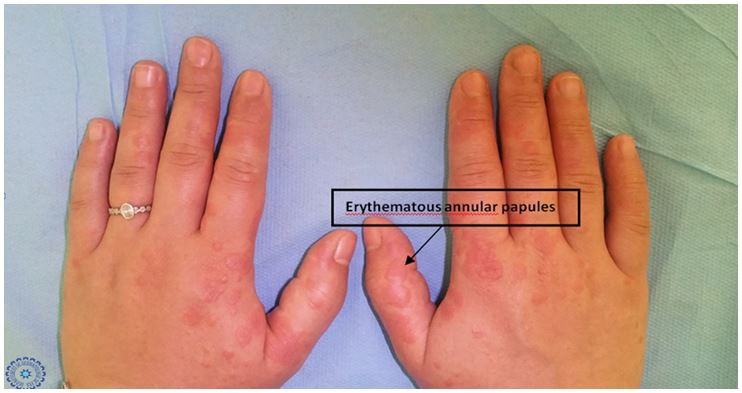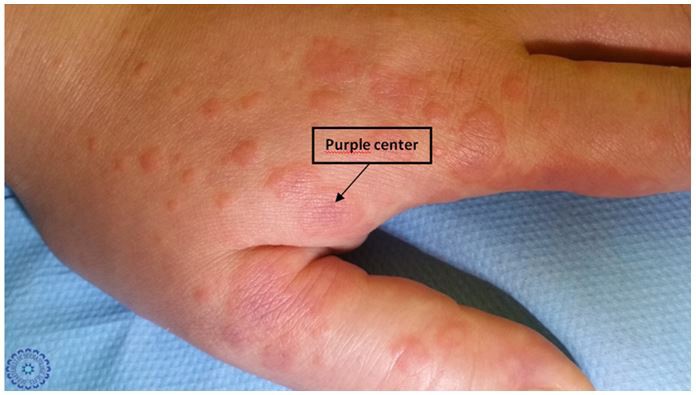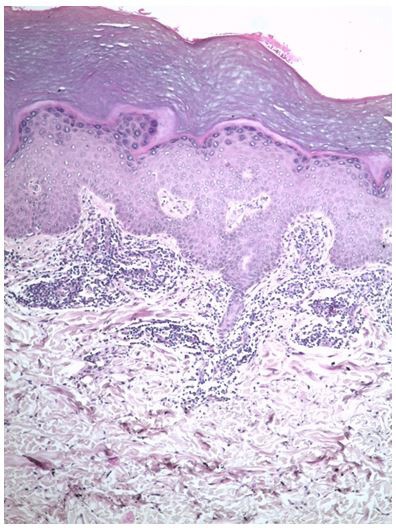Erythematous Papules and Patches on the Hands
Introduction:Erythema elevatum diutinum is a rare and chronic skin disorder. Clinically is characterized by red, purple, brown or yellow papules, plaques or nodules. These lesions are usually symmetrically distributed on the extensor surfaces of the extremities. Histologically, early lesions of erythema elevatum diutinum show leukocytoclastic vasculitis. We report a case of erythema elevatum diutinum in a pregnant woman. This patient is middle aged woman, with multiple pruritic lesions of the hands. After laboratory studies (erythrocyte sedimentation rate, C reactive protein, protein electrophoresis, serological test) and biopsy of lesions we confirmed a diagnosis of erythema elevatum diutinum. A paraclinical assessment of association with other diseases was made returning without abnormalities. Given localized lesions without systemic signs, the patient was started on topical corticosteroids with good progress until delivery, and remained in remission for two years.
Keywords:Erythema Elevatum Diutinum; Leukocytoclastic Vasculitis; Differential Diagnosis
A 29-year-old woman, pregnant at 34 weeks of amenorrhea, presented with fixed, itchy and symmetric erythematous lesions on both hands, without other systemic signs or previous infection. The initial clinical examination revealed the presence of erythematous papules and patches, with an infiltrated border and a depressed center giving an annular appearance, and others with a purplish, sometimes edematous center, on the dorsal aspect of both hands along with palmar involvement, in a symmetric manner (Figure 1A and 1B). There was no lymphadenopathy present. A skin biopsy from an erythematous infiltrated patch was obtained.
A. Granuloma annular
B. Sweet syndrome
C. Erythema Elevatum Diutinum
D. Erythema multiform
C. Erythema Elevatum Diutinum
Microscopic Findings and Clinical Course: The biopsy specimen revealed an oedematous and slightly fibrous superficial reticular dermis, which contains inflammatory infiltrates arranged in perivascular cuffs essentially made of lymphocytes mixed with some histiocytes associated with some neutrophilic leucocytes with discrete leucocytoclasia. These elements penetrate the vascular wall. It associates discrete perivascular and parietal fibrinoid deposits (Figure 1C and 1D).
Clinicohistopathologic correlation supported the diagnosis of erythema elevatum diutinum (EED). A paraclinical assessment of association with other diseases was made returning without abnormalities. Given localized lesions without systemic signs, the patient was started on topical corticosteroids with good progress until delivery, and remained in remission for two years.
Erythema Elevatum Diutinum (EED) is a rare and infrequent form of leukocytoclastic vasculitis. It is more frequent in adults between the third and sixth decades of life, presenting at any age [1]. It is most likely mediated by immune complexes, and is associated with autoimmune, neoplastic, hematological and infectious processes [2-4].
The lesions manifests as symmetrical, firm, yellow or pinkish to red, purple or brown papules, plaques or nodules on the backs of the hands, feet and extensor surfaces of the extremities overlying joints [5]. Although lesions are often asymptomatic, patients often experience pruritus, tenderness, and local burning sensation [4,6,7].
Histologically, the lesions are characterized by a leukocytoclastic vasculitis, with large endothelial edema in the small vessels of the upper and middle dermis, foci of fibrinoid degeneration called toxic hyaline of the vascular wall and a perivascular lymphocytic inflammatory infiltrate [8,9].
Clinicopathologic correlation is important for the diagnosis as EED lesions may sometimes mimic a variety of cutaneous diseases, such as Sweet syndrome, pyoderma gangrenosum, sarcoidosis, granuloma annulare and erythema multiforme [4,10].
The treatment of EED is difficult because of its chronic and recurrent course [11]. Dapsone is considered a first-line treatment for early lesions [7]. In the second line, colchicine, tetracycline and systemic steroids have been used with limited success [12]. The lesions of erythema elevatum diutinum resolved after one week of topical steroid use and remained in remission for one year [5]. As the case of our patient. In late lesions, the use of intralesional corticosteroids and surgical excision gave promising results [13]. Patients with underlying disorders or infections should benefit from targeted treatment of the underlying etiology, which could improve the results of EED [7].
Erythema Elevatum Diutinum is a rare chronic form of cutaneous vasculitis. It can imitate several pathologies. Although its cause is unknown, infections and systemic disorders associated with EED have been described: streptococcal infection, HIV infection, rheumatoid arthritis and monoclonal gammopathies. The association with pregnancy is very rare but can be explained by the fact that the latter is a temporary semi-allograft that survives for nine months, evolving favorably after delivery as is the case of our patient [14].
Written informed consent was obtained from the patient for publication of this case and any accompanying images. A copy of the written consent is available for review by the Editor-in-Chief of this journal.
Not applicable.
The authors declare that they have no conflicts of interest.
The authors declare no fundings.




